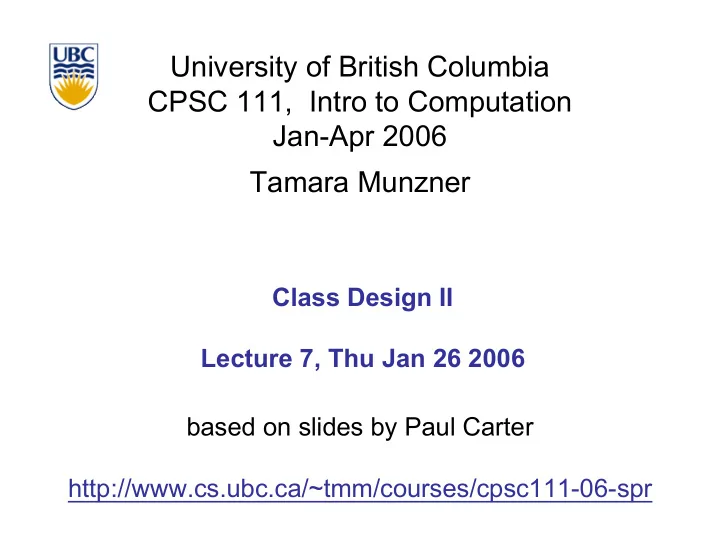

University of British Columbia CPSC 111, Intro to Computation Jan-Apr 2006 Tamara Munzner Class Design II Lecture 7, Thu Jan 26 2006 based on slides by Paul Carter http://www.cs.ubc.ca/~tmm/courses/cpsc111-06-spr
Reading This Week ■ Chap 3 ■ Reading for next week ■ re-read Chapter 4.1-4.6
News ■ Assignment 1 due Tue Jan 31 5pm ■ Extra TA hours in ICICS 008 to answer questions ■ Thu Jan 24 (today!) 4-6pm ■ Olivia Siu ■ Fri Jan 25 5-7pm ■ Ciaran Llachlan Leavitt ■ Sat Jan 26 12:30-2:30pm ■ Simon Hastings ■ Weekly questions due today ■ Stay tuned for bboard postings with (some) answers ■ Midterm reminder: Tue Feb 7, 18:30 - 20:00 ■ Geography 100 & 200
Recap: Escape Characters ■ How can we make a String that has quotes? ■ String foo = “oh so cool”; ■ String bar = “oh so \”cool\”, more so”; ■ Escape character: backslash ■ general principle
Recap: Random Numbers ■ Random class in java.util package ■ public Random() ■ Constructor ■ public float nextFloat() ■ Returns random number between 0.0 (inclusive) and 1.0 (exclusive) ■ public int nextInt() ■ Returns random integer ranging over all possible int values ■ public int nextInt( int num ) ■ Returns random integer in range 0 to (num-1)
Recap: Abstraction ■ Abstraction: process whereby we ■ hide non-essential details ■ provide a view that is relevant ■ Often want different layers of abstraction depending on what is relevant
Recap: Encapsulation and Info Hiding ■ Encapsulation: process whereby ■ inner workings made inaccessible to protect them and maintain their integrity ■ operations can be performed by user only through well-defined interface. ■ aka information hiding ■ Hide fields from client programmer ■ maintain their integrity ■ allow us flexibility to change them without affecting code written by client programmer ■ Parnas' Law: ■ "Only what is hidden can by changed without risk."
Recap: Designing Classes ■ Blueprint for constructing objects ■ build one blueprint ■ manufacture many instances from it ■ Consider two viewpoints ■ client programmer: want to use object in program ■ what public methods do you need ■ designer: creator of class ■ what private fields do you need to store data ■ what other private methods do you need
Recap: UML ■ UML diagram representing class design Classname - field: type - method(): return type private + Classname() + field: type + method(): return type public + method(param1 type, param2 type): return type
Recap: UML ■ UML diagram for Die class we designed Die - sides: int private + Die() + setSides(numSides: int): void public + roll(): int
Objectives ■ understand how to design new classes using abstraction and encapsulation ■ understand how to implement new classes in Java
Implementing Die ■ Last time ■ designed UML diagram ■ first draft of implementation ■ it compiled, but untested! ■ This time ■ refine implementation ■ test and debug implementation
Using Die ■ Change hats from Die designer to Die user ■ Roll two dice ■ print each value, and sum ■ Design and implement RollDice driver: class with main method
Implementing RollDice public class RollDice { public static void main ( String [] args) { }
Separation and Modularity ■ Design possibilities ■ Die and RollDie as separate classes ■ one single class that does it all ■ Separation allows code re-use through modularity ■ another software design principle ■ One module for modeling a die: Die class ■ Other modules can use die or dice ■ we wrote one, the RollDice class ■ Modularization also occurs at file level ■ modules stored in different files ■ also makes re-use easier
Control Flow Between Modules ■ So far, easy to understand control flow: order in which statements are executed ■ march down line by line through file ■ Now consider control flow between modules Die class methods Client code public int roll() int rollResult; { myDie.setSides(); … } rollResult = myDie.roll(); public void setSides() { … }
Designing Point : UML ■ class to represent points in 2D space
Implementing Point public class Point { }
Formal vs. Actual Parameters ■ formal parameter: in declaration of class ■ actual parameter: passed in when method is called ■ variable names may or may not match ■ if parameter is primitive type ■ call by value: value of actual parameter copied into formal parameter when method is called ■ changes made to formal parameter inside method body will not be reflected in actual parameter value outside of method ■ if parameter is object: covered later
Scope ■ Fields of class are have class scope: accessible to any class member ■ in Die and Point class implementation, fields accessed by all class methods ■ Parameters of method and any variables declared within body of method have local scope: accessible only to that method ■ not to any other part of your code ■ In general, scope of a variable is block of code within which it is declared ■ block of code is defined by braces { }
Key Topic Summary Borrowed phrasing from Steve Wolfman ■ Generalizing from something concrete ■ fancy name: abstraction ■ Hiding the ugly guts from the outside ■ fancy name: encapsulation ■ Not letting one part ruin the other part ■ fancy name: modularity ■ Breaking down a problem ■ fancy name: functional decomposition
Recommend
More recommend